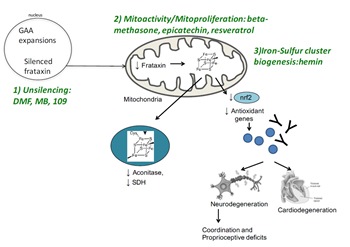As cardiac disease is part of the phenotypic spectrum of several movement disorders, heart involvement should be carefully investigated and increased awareness of this association encouraged as it may represent a leading cause of morbidity and mortality.
Wednesday, July 28, 2021
Cardiac Involvement in Movement Disorders
Rossi M, Wainsztein N, Merello M.; Mov Disord Clin Pract. 2021 Apr 7;8(5):651-668. doi: 10.1002/mdc3.13188. PMID: 34307738; PMCID: PMC8287161.
Tuesday, July 27, 2021
Neuro-Ophthalmological Findings in Friedreich’s Ataxia
Rojas, P.; de Hoz, R.; Cadena, M.; Salobrar-García, E.; Fernández-Albarral, J.A.; López-Cuenca, I.; Elvira-Hurtado, L.; Urcelay-Segura, J.L.; Salazar, J.J.; Ramírez, J.M.; Ramírez, A.I.; J. Pers. Med. 2021, 11, 708. doi:10.3390/jpm11080708
Although most patients with FRDA do not present with symptomatic visual impairment, 73% present with clinical neuro-ophthalmological alterations such as optic atrophy and altered eye movement, among others. This review provides a brief overview of the main aspects of FRDA and then focuses on the ocular involvement of this pathology and the possible use of retinal biomarkers.
Monday, July 26, 2021
Very late-onset Friedreich’s ataxia with rapid course mimicking as possible multiple system atrophy cerebellar type
Tushar Ashok Vidhale, Hemant R Gupta, Rohan PJ and Charmi Gandhi; BMJ Case Reports CP 2021;14:e242073, doi:10.1136/bcr-2021-242073
This 55-year-old man was admitted to the hospital with an insidious onset, progressive backward fall (due to severe truncal ataxia), dysarthria, stiffness in extremities, distal dominant muscle wasting along with behavioural changes and urinary incontinence. Clinical assessment indicated mild cognitive decline (Mini-Mental State Examination 22/27) with cerebellar, pyramidal and peripheral nerves involvement. On investigations, nerve conduction studies revealed symmetrical, sensorimotor peripheral neuropathy affecting both lower limbs. Brain and whole spine MRI revealed widespread cerebral and mild cerebellar atrophy, pons and medulla volume loss, and a normal spinal cord. Transthoracic echocardiography revealed concentric left ventricular hypertrophy. His gene analysis revealed eight GAA repeats on allele 1, and 37 GAA repeats on allele 2 in the first intron of the frataxin gene. Considering his clinical profile and genetic analysis, he was diagnosed as a case of very late-onset Friedreich’s ataxia with likely compound heterozygous genotype.
Monday, July 19, 2021
A Study to Assess Efficacy, Long Term Safety and Tolerability of RT001 in Subjects With Friedreich's Ataxia
UCLA Health, NCT No. NCT04102501; Phase 3
The purpose of this study is to assess the Efficacy, Long Term Safety and Tolerability of RT001 in subjects with Friedreich's Ataxia
Open Actively Recruiting
Sunday, July 18, 2021
Rare occurrence of severe blindness and deafness in Friedreich ataxia: a case report
Joana Damásio, Ana Sardoeira, Maria Araújo, Isabel Carvalho, Jorge Sequeiros & José Barros; Cerebellum & Ataxias volume 8, Article number: 17 (2021) doi:10.1186/s40673-021-00140-6
With this report we wish to further contribute to the characterization of optic and auditory involvement in FRDA, stress the need to better understand the underlying mechanisms, as well as their genetic and epigenetic modifying factors (including somatic heterogeneity); and increase awareness for this rare extreme phenotype. Improved healthcare services and longer survival of early-onset patients will probably increase the frequency of these devastating manifestations.
Saturday, July 17, 2021
Gene therapies and COVID-19 vaccines: a necessary discussion in relation with viral vector-based approaches
Angel Aledo-Serrano, Antonio Gil-Nagel, Julian Isla, Ana Mingorance, Fernando Mendez-Hermida & Ruben Hernandez-Alcoceba; Orphanet J Rare Dis 16, 316 (2021). doi:10.1186/s13023-021-01958-3
In conclusion, the potential interference between gene therapy and virus-based vaccines deserves a careful consideration and discussion involving the patient community. This is a adequate moment to do so, since current vaccine candidates are not expected to cause such interference. Should people with monogenic diseases preferentially receive, or be given the option to be immunized COVID-19 vaccines based on non-viral platforms, such as the mRNA vaccines? A careful consideration of the impact on the use of vectors for vaccine production and the plausible negative impact in the development of suitable gene therapy medicinal products, should be on top of the scientific and regulatory table discussion in order to facilitate access to patients suffering monogenic diseases and also prevent unnecessary delays in future vector vaccines development.
Friday, July 16, 2021
Myocardial Perfusion Reserve in Children with Friedreich Ataxia
Hutchens JA, Johnson TR, Payne RM.; Pediatric Cardiology. 2021 Jul. DOI: 10.1007/s00246-021-02675-1.
This retrospective study shows that children with FA develop MPR defects early in the disease process. It also suggests MPR may be a sensitive tool to evaluate underlying cardiac compromise and could be of use in directing surgical management decisions in children with FA.
Wednesday, July 14, 2021
Interruptions of the FXN GAA Repeat Tract Delay the Age at Onset of Friedreich’s Ataxia in a Location Dependent Manner
Nethisinghe, S.; Kesavan, M.; Ging, H.; Labrum, R.; Polke, J.M.; Islam, S.; Garcia-Moreno, H.; Callaghan, M.F.; Cavalcanti, F.; Pook, M.A.; Giunti, P. Int. J. Mol. Sci. 2021, 22, 7507. doi:10.3390/ijms22147507
The GAA repeat tract in some cases may be impure with sequence variations called interruptions. It has previously been observed that large interruptions of the GAA repeat tract, determined by abnormal MboII digestion, are very rare. Here we have used triplet repeat primed PCR (TP PCR) assays to identify small interruptions at the 5′ and 3′ ends of the GAA repeat tract through alterations in the electropherogram trace signal. We found that contrary to large interruptions, small interruptions are more common, with 3′ interruptions being most frequent. Based on detection of interruptions by TP PCR assay, the patient cohort (n = 101) was stratified into four groups: 5′ interruption, 3′ interruption, both 5′ and 3′ interruptions or lacking interruption. Those patients with 3′ interruptions were associated with shorter GAA1 repeat tracts and later ages at disease onset. The age at disease onset was modelled by a group-specific exponential decay model. Based on this modelling, a 3′ interruption is predicted to delay disease onset by approximately 9 years relative to those lacking 5′ and 3′ interruptions. This highlights the key role of interruptions at the 3′ end of the GAA repeat tract in modulating the disease phenotype and its impact on prognosis for the patient.
Would Francisco Soca have been the first to relate toe phenomenon as pyramidal disorders?
élio A.G. Teive, Carlos Henrique F. Camargo, Nicolás Sommaruga, Héctor Ignacio Amorin-Costábile, Olivier Walusinski; Journal of Clinical Neuroscience, Volume 91, 2021, Pages 172-175, doi:10.1016/j.jocn.2021.07.013.
The Uruguayan physician Francisco Soca, who specialized in neurology in Jean-Martin Charcot’s clinic, defended a thesis at the Paris Faculty of Medicine in 1888 on Friedreich's ataxia in eleven patients. In this work he described the presence of toe phenomenon.
In the late 1800s Soca completed a specialization in neurology at the service run by Charcot in Paris. He defended an important thesis in 1888 assessing data from 11 Friedreich’s ataxia. In his thesis, Soca also described the toe phenomenon and the presence of structural changes in the feet of these patients that were not described in the Friedreich study published in 1863. The Soca’s thesis contained the description of toe extension associated with pyramidal tract lesions, eight years later described and further immortalized as Babiński's sign. Therefore, Soca had already publicized this sign as being representative of a pyramidal dysfunction before Babiński or any other neurologist.
Sunday, July 11, 2021
A systematic review of moral reasons on orphan drug reimbursement
Zimmermann, B.M., Eichinger, J. & Baumgartner, M.R.; Orphanet J Rare Dis 16, 292 (2021). doi:10.1186/s13023-021-01925-y
This study aims to provide a systematic analysis of moral reasons for and against such a special status for the reimbursement of OMPs in publicly funded healthcare systems from a multidisciplinary perspective.
Results suggest that OMP reimbursement issues should be assessed and analysed from a multidisciplinary perspective. Despite the higher occurrence of reasons and articles in favour of a special status, there is no clear-cut solution for this ethical challenge. The binary perspective of whether or not OMPs should be granted special status oversimplifies the issue: both OMPs and rare diseases are too heterogeneous in their characteristics for such a binary perspective. Thus, the scientific debate should focus less on the question of disease prevalence but rather on how the important variability of different OMPs concerning e.g. target population, cost-effectiveness, level of evidence or mechanism of action could be meaningfully addressed and implemented in Health Technology Assessments.
Thursday, July 8, 2021
Stealth BioTherapeutics Joins the Rare Disease Company Coalition
BOSTON, July 7, 2021 /PRNewswire/ -- Stealth BioTherapeutics Corp (Nasdaq: MITO).
The Coalition will engage with policy stakeholders to advocate for impactful drug and healthcare policies and regulations currently under discussion, including prescription drug pricing, to highlight the consequences that blanket legislation can have on continued innovation for rare disease treatments.
Wednesday, July 7, 2021
The Cost of Living with Inherited Ataxia in Ireland
Mark J. Kelly, Petya Bogdanova-Mihaylova, Joshua Skeens, Sharon Moran, Sorcha Farrelly, Richard A. Walsh & Sinéad M. Murphy. Cerebellum (2021). doi:10.1007/s12311-021-01271-6
Inherited ataxias carry high financial costs to the health system, patients, caregivers and society as a whole. Costs are similar between FRDA and other forms of inherited ataxia and grow as disability increases over the course of the illness. Indirect costs or ‘productivity losses’ make up half the COI and place a significant financial burden on patients. Despite this, there is evidence to suggest that certain clinical standards of care such as frequency of clinician review, OHP input and monitoring investigations are not being met, possibly reflecting the limited availability of resources. The results of this study advocate the need for greater funding in inherited ataxia care in Ireland to ease the financial burden on patients and improve resource availability.
Tuesday, July 6, 2021
Clinical trials: regulators’ inaction has left EU registry “riddled with inaccurate and missing data”
BMJ 2021; 374 doi: doi:10.1136/bmj.n1707 (Published 05 July 2021), Cite this as: BMJ 2021;374:n1707
Nearly 6000 clinical trial results are currently missing from the European trial registry, despite transparency rules requiring countries to upload results within 12 months of trial completion, a report has found.
Researchers from the University of Oxford said the findings show that medicines regulators in the 14 European countries included in the report have failed to ensure that important data on new drugs and vaccines are rapidly and consistently made public.
The report, published 5 July, found that the largest gaps were in Italy (1221 results missing), Spain (884), the Netherlands (839), France (698), and Germany (554).
Identifying the most potent and effective treatment of Friedreich ataxia
Brunel University London, Dr Mark Pook.
This project aims to identify the most potent and effective known drugs to investigate treatment of the inherited disease, Friedreich ataxia, motivating pharma to fund more clinical trials.
This international collaborative project between the Cortopassi, Giunti and Pook laboratories aims to test a number of differently-acting drug compounds to identify the most potent and effective known drugs to address Friedreich ataxia.
Monday, July 5, 2021
Molecular Details of the Frataxin-Scaffold Interaction during Mitochondrial Fe-S Cluster Assembly
Campbell CJ, Pall AE, Naik AR, Thompson LN, Stemmler TL.; Int J Mol Sci. 2021 Jun 2;22(11):6006. doi: 10.3390/ijms22116006.
These details support a complex dynamic interaction between the FXN and ISCU proteins when both are part of the NIAUF complex and this provides additional insight into the coordinated mechanism of Fe-S cluster assembly.
Sunday, July 4, 2021
Clinical Ethics Consultation in Neurology – a case series
Benjamin Ilse, Bernd Alt-Epping, Albrecht Günther, Jan Liman & Alfred Simon; BMC Neurol 21, 216 (2021). doi:10.1186/s12883-021-02244-2
The concept of clinical ethics consultation (CECs) was implemented to provide support in ethical controversies in clinical settings and are offered in at least every second hospital in Germany. Neurological disorders often require complex decision-making. The aims of this study were to determine which situations lead to CEC in neurology and to investigate the influence of the individual patient’s wishes on the recommendation.
Saturday, July 3, 2021
Friedreich's ataxia researcher Associate Professor Mirella Dottori has received a funding boost
JULY 2 2021, Associate Professor Mirella Dottori, a researcher at the University of Wollongong will receive $982,861 over three years from the Medical Research Future Fund (MRFF) and National Health and Medical Research Council (NHMRC) for her ground-breaking research into Friedreich's ataxia.
Subscribe to:
Posts (Atom)


